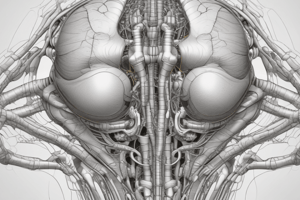Podcast
Questions and Answers
A rugby player is throwing the ball during a lineout.
Identify the following when the ball is released:
• the type of joint operating at the elbow
• the agonist muscle causing the movement at the elbow when releasing the ball (with a straight arm)
• the type of contraction occurring in the ‘agonist’ muscle at the elbow to cause this movement
(3 marks)
A rugby player is throwing the ball during a lineout.
Identify the following when the ball is released: • the type of joint operating at the elbow • the agonist muscle causing the movement at the elbow when releasing the ball (with a straight arm) • the type of contraction occurring in the ‘agonist’ muscle at the elbow to cause this movement (3 marks)
Hinge Joint The tricep is the agonist muscle when the ball is released Concentric contraction
Define flexibility. Evaluate the importance of flexibility for Helen as she performs in gymnastics. [4 marks]
Define flexibility. Evaluate the importance of flexibility for Helen as she performs in gymnastics. [4 marks]
Award one mark for defining flexibility and up to a further three marks for evaluating its importance to Helen as she performs gymnastics.
Flexibility is the range of movement possible at a joint (1) • To enable her to perform a wide range of complex skills, such as the splits so that she can perform higher tariff routines (1) • There are some ways to learn a skill that can only be achieved if Helen is flexible eg backward walkovers (1) • So that she can look aesthetically pleasing, such as pointed fingers and toes which will enable her to score higher marks (1) • To increase the range of movement at a joint or elasticity of the muscles so she has less chance of straining or tearing a muscle (1) • Flexible joints require less energy to move through a greater range of motion. This is necessary in her floor routine which is over a certain length of time (1) • Gaining height to perform somersaults (power) could be deemed important so she can execute the skill safely or correctly or equivalent component of fitness (1)
Explain how Ibrahim’s skeletal and muscular system work together to bring about movement. [3 marks]
Explain how Ibrahim’s skeletal and muscular system work together to bring about movement. [3 marks]
Award one mark for each of the following points up to a maximum of three marks. • Muscles are attached to bones by tendons (1) • When muscles contract they pull on the bones to create movement(1) • Muscles work in (antagonistic) pairs (1) • When one muscle in the pair is contracting (agonist) the other is relaxing (antagonist)(1) Maximum 3 marks
Matthew is a Year 7 student who is a very good all box -round sportsman. He has recently undertaken a series of fitness tests to measure his fitness levels.
The multi stage fitness test was used to measure Matthew’s cardiovascular endurance.
Describe the multi stage fitness test. [4 marks]
Matthew is a Year 7 student who is a very good all box -round sportsman. He has recently undertaken a series of fitness tests to measure his fitness levels.
The multi stage fitness test was used to measure Matthew’s cardiovascular endurance.
Describe the multi stage fitness test. [4 marks]
Explain how a 1500m runner could use speed to their advantage in a 1500m race. [3 marks]
Explain how a 1500m runner could use speed to their advantage in a 1500m race. [3 marks]
Identify the joint action taking place at the elbow as the arm moves from the downward phase of a bicep curl to the upward phase of a bicep curl. [1 mark]
Identify the joint action taking place at the elbow as the arm moves from the downward phase of a bicep curl to the upward phase of a bicep curl. [1 mark]
Identify the main antagonist at the elbow as the arm moves from the downward phase of a bicep curl to the upward phase of a bicep curl. [1 mark]
Identify the main antagonist at the elbow as the arm moves from the downward phase of a bicep curl to the upward phase of a bicep curl. [1 mark]
Identify the type of muscle contraction that is taking place at the elbow as the arm moves from the downward phase of a bicep curl to the upwards phase of a bicep curl. [1 mark]
Identify the type of muscle contraction that is taking place at the elbow as the arm moves from the downward phase of a bicep curl to the upwards phase of a bicep curl. [1 mark]
The Sit and Reach Test measures flexibility.
Describe how to carry out this test. [3 marks]
The Sit and Reach Test measures flexibility. Describe how to carry out this test. [3 marks]
Flashcards
Flexibility
Flexibility
The range of movement possible at a joint.
How muscles create movement
How muscles create movement
Muscles are attached to bones by tendons. When muscles contract, they pull on the bones to create movement. Muscles work in antagonistic pairs.
Multi-Stage Fitness Test
Multi-Stage Fitness Test
A series of timed bleeps, shuttle runs 20m apart, performers have to touch lines (or cones). Bleeps get progressively closer together. Miss three bleeps, performer has to drop out. It is progressive and maximal.
Using speed in a 1500m race
Using speed in a 1500m race
Signup and view all the flashcards
Flexion
Flexion
Signup and view all the flashcards
Antagonist
Antagonist
Signup and view all the flashcards
Concentric contraction
Concentric contraction
Signup and view all the flashcards
Sit and Reach Test
Sit and Reach Test
Signup and view all the flashcards
Hinge Joint
Hinge Joint
Signup and view all the flashcards




